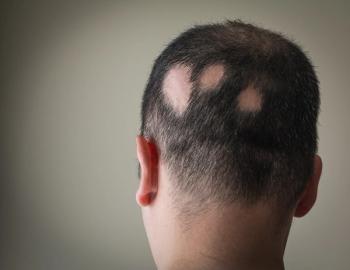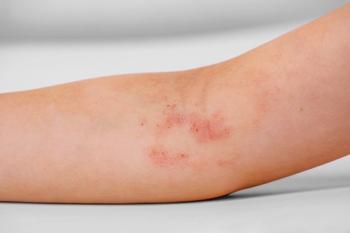
Tinea Capitis
In this infant, microscopic examination of a potassium hydroxide preparation of scalp scrapings revealed Trichophyton tonsurans, which is the most common causative organism in North America.
FigureThis circular lesion on the scalp of a 3-week-old infant is tinea capitis-a rare disorder in a neonate. A 2003 epidemiological survey revealed a striking increase in tinea capitis among African American children. The study showed that the carrier rate for scalp fungus with cultures that are positive for dermatophytes was up to 13% among African American children in elementary school.
1
In this infant, microscopic examination of a potassium hydroxide preparation of scalp scrapings revealed Trichophyton tonsurans, which is the most common causative organism in North America.
Treatment of tinea capitis is variable. Most medications are not FDA-approved, and few published trials discuss treatment for very young children. Most experts use high-dose oral griseofulvin (20 to 25 mg/kg/d for 6 to 8 weeks) as first-line therapy, because lower dosages have been proved to have higher treatment failures. Several other equally effective therapies, such as terbinafine, itraconazole, and fluconazole (at 3 to 6 mg/kg/d for 2 to 4 weeks), have been used outside the United States and off-label; however, these treatments cost significantly more.2 There is one report of a 16-day-old infant who did well after treatment with topical bifonazole 1%.3 Selenium sulfide shampoo can be used as adjunctive therapy.
In this infant, treatment with griseofulvin (20 mg/d for 6 weeks) led to complete resolution of the lesion with no side effects.
References:
- Ghannoum M, Isham N, Hajjeh R, et al. Tinea capitis in Cleveland: survey of elementary school students. J Am Acad Dermatol. 2003;48:189-193.
- Roberts BJ, Friedlander SF. Tinea capitis: a treatment update. Pediatr Ann. 2005;34:191-200.
- Mosseri R, Finkelstein Y, Garty BZ. Topical treatment of tinea capitis in a neonate. Cutis. 2002;69:88-90.
Newsletter
Access practical, evidence-based guidance to support better care for our youngest patients. Join our email list for the latest clinical updates.














